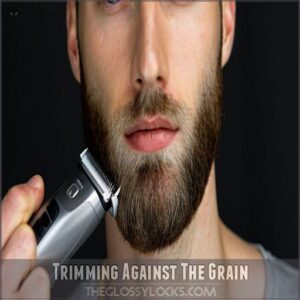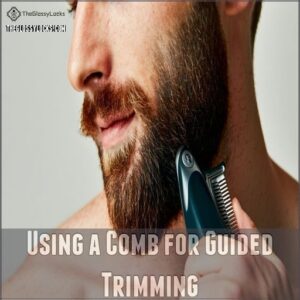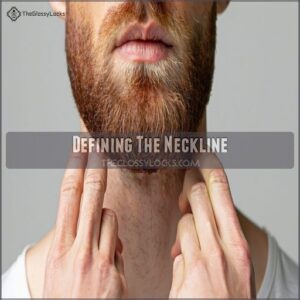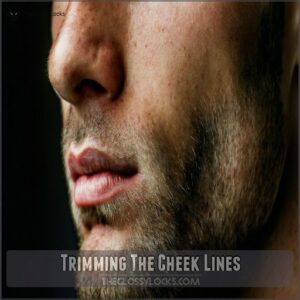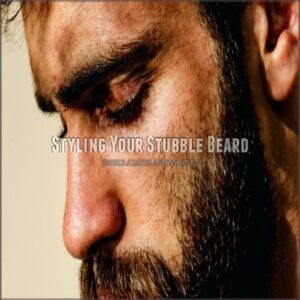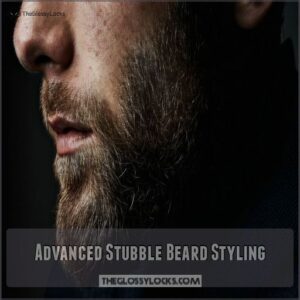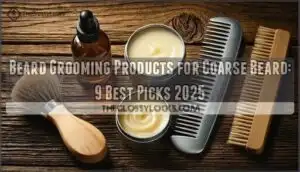This site is supported by our readers. We may earn a commission, at no cost to you, if you purchase through links.
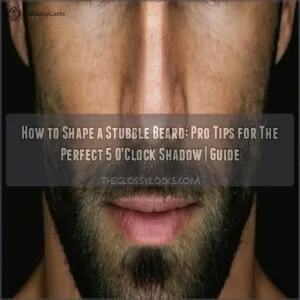 To shape a stubble beard like a pro, start by letting your facial hair grow for 2-3 days.
To shape a stubble beard like a pro, start by letting your facial hair grow for 2-3 days.
Your face shape matters. Oval faces can rock any length, while square faces benefit from shorter sides to soften angles.
Trim against the grain using a precision wheel set between 2-5mm. Define that neckline (trust us, it makes all the difference).
Keep your edges clean with a detail trimmer, and maintain symmetry by working in slow, deliberate strokes.
A good beard oil will keep your stubble soft and skin happy. There’s an art to perfecting those crisp lines and natural-looking fades that’ll turn heads.
Table Of Contents
- Key Takeaways
- Choosing The Right Stubble Length
- Trimming for an Even Stubble
- Shaping The Stubble Beard
- Maintaining a Defined Edge
- Styling Your Stubble Beard
- Common Mistakes to Avoid
- Advanced Stubble Beard Styling
- Frequently Asked Questions (FAQs)
- What face shape is best for stubble?
- How to get a perfect stubble beard?
- What is the most attractive beard length for stubble?
- How do I get my beard stubble to lay flat?
- Should you shape a stubble beard?
- How to style your stubble beard?
- How to line up a stubble beard?
- How to care for stubble beard?
- How do I choose the right trimmer for my stubble?
- Can I dye my stubble to match my hair color?
- Conclusion
Key Takeaways
- Let your facial hair grow for 2–3 days, then use a precision trimmer set between 2–5 mm against the grain, focusing on maintaining an even length for a professional look.
- Define your neckline by placing two fingers above your Adam’s apple and creating a U-shaped curve from ear to ear—trim everything below this line for a clean, polished appearance.
- You’ll achieve the best results by matching your stubble style to your face shape—oval faces can wear any length, while square faces benefit from shorter sides to soften angles.
- Keep your stubble healthy by applying beard oil daily, trimming every 2–3 days, and using a detail trimmer for precise edges along your cheeks and jawline.
Choosing The Right Stubble Length
You’ll find your perfect stubble length by testing different trimmer settings until you get that just-right look that matches your face shape and personal style.
Getting this foundation right means you won’t end up looking like you’ve been stranded on a desert island or just forgot to shave for a few days.
Understanding Your Face Shape
Getting your stubble just right starts with face shape analysis – it’s like finding the perfect frame for a masterpiece. Your facial structure plays a key role in determining how to shape your stubble for maximum impact.
Understanding your face shape is important for making informed decisions about style and beauty, including stubble grooming.
- Oval faces can rock any stubble length, creating natural contouring
- Square faces benefit from shorter sides to soften angular features
- Round faces look best with defined lines and angular shadow
- Heart-shaped faces shine with fuller chin stubble for balance
This shape-specific approach guarantees your stubble complements your unique features perfectly.
Determining Your Ideal Stubble Length
Your ideal stubble length depends on several key factors that make your look uniquely yours, while your face shape sets the foundation. Your perfect stubble should complement your features and lifestyle.
- Follicle density impact determines how thick your stubble appears
- Growth rate assessment helps plan your trimming schedule
- Skin sensitivity factors influence comfortable length choices
- Desired look visualization guides your style goals
Consider experimenting with lengths between 2-5mm to find your sweet spot.
Using a Precision Wheel for Accuracy
How well do you know your precision wheel? Your trimmer’s precision wheel is your secret weapon for consistent results. Investing in a precision trimmer can elevate your grooming experience. Let’s master those wheel adjustment techniques for the perfect stubble.
| Setting | Length | Look | Best For |
|---|---|---|---|
| 0.5-1mm | Ultra-short | Sharp, defined | Professional settings |
| 1-2mm | Short | Classic shadow | Everyday wear |
| 2-3mm | Medium | Rugged charm | Casual style |
| 3-4mm | Heavy | Bold statement | Weekend vibes |
Start with a higher setting and gradually work your way down until you find your sweet spot. Regular wheel maintenance keeps your trimmer performing at its best.
Experimenting With Different Lengths
Now that you’re comfortable with your precision wheel, let’s play with different stubble lengths to find your signature look. Your trimmer guard settings are your best friend here.
Start with shorter lengths and work your way up:
- 0.5mm gives you that classic 5 o’clock shadow – perfect for daily office wear
- 1mm creates a natural, light coverage that works for most face shapes
- 2mm adds definition and helps hide patchy spots
- 3-4mm ventures into heavy stubble territory, great for contouring strong jawlines
Think of gradual length changes like finding the right pair of jeans – it takes some trial and error to nail your perfect fit.
Trimming for an Even Stubble
You’ll be amazed at how a few simple trimming tricks can transform your patchy stubble into that perfect designer shadow you’ve been dreaming about.
With the right technique and tools, you’ll learn to trim against the grain and use a comb as your guide for that consistently rugged look that turns heads.
Trimming Against The Grain
Once you’ve locked in your ideal stubble beard length, trimming against the grain is your secret weapon for that perfect 5 o’clock shadow.
Start with shorter passes, moving your beard trimmer upward from neck to cheeks.
Multiple strokes in opposite directions catch those stubborn hairs that grow differently.
Keep your blade sharpness in check to avoid skin irritation – dull blades can turn this simple task into a real pain.
Achieving Consistent Length
Want your stubble beard to look like it’s been shaped by a pro? Master the art of consistent length by dialing your trimmer settings in tiny 0.5mm steps.
Here’s what the pros do:
- Start with a higher guard setting, then gradually decrease
- Make multiple passes in different grain directions
- Use a beard comb between passes to lift hair
- Apply steady, even pressure throughout trimming
- Double-check trouble spots like chin and jaw angles
Avoiding Patches and Unevenness
When dealing with patchy stubble growth, the key to achieving facial symmetry lies in proper stubble care and maintenance.
Your beard’s fullness depends on consistent shaping and nourishment.
- Apply beard fillers to sparse areas, blending them naturally with existing growth
- Combat skin irritation with daily moisturizing and gentle exfoliation
- Master stubble beard shaping by trimming at a consistent length, focusing on trouble spots
Using a Comb for Guided Trimming
Nailing those tricky patches? Let’s level up your stubble beard trimming game with a comb.
Attach your favorite beard comb to your trimmer and set it to your ideal stubble length – this combo’s your secret weapon for guided edges and even textures.
To achieve the perfect trim, consider investing in a high-quality Beard Trimming tool.
Follow your beard’s natural growth pattern as you shape your stubble beard, keeping steady pressure for that perfectly uniform trim every time.
Shaping The Stubble Beard
You’ll need a steady hand and the right tools to transform your scruffy stubble into a sharp, defined look that turns heads.
Creating clean lines along your neck and cheeks while paying attention to your jawline will give you that intentionally rugged appearance that’s become a modern style statement.
Defining The Neckline
The stubble beard neckline makes or breaks your facial framing game.
Finding your perfect neckline’s easy – place two fingers above your Adam’s apple and imagine a U-shape curve from ear to ear through that point.
For jawline definition and edge control, trim everything below this line. Keep your beard borders clean by maintaining this shape daily with a precision trimmer for that deliberately rugged look.
Creating a Straight Edge
Standing in front of your mirror, let’s perfect that straight Edge Control.
For precise Beard Lines, hold your trimmer at a 90-degree angle against your skin’s natural contours.
Work deliberately to maintain Facial Symmetry, starting from your ear and following your established stubble beard neckline.
A steady hand’s essential – take your time and use short, controlled strokes for crisp Stubble Borders and perfect Jawline Definition.
Trimming The Cheek Lines
Now that you’ve got those straight edges down, let’s nail those cheek lines for perfect stubble beard grooming. Creating clean stubble borders starts with finding your natural cheek line and enhancing it.
To achieve a sharp look, mastering the beard trimming techniques is essential for maintaining well-defined facial hair.
Here’s your game plan for flawless facial hair maintenance:
- Map your natural growth pattern using your fingers to feel where hair density changes
- Start trimming from the highest point of growth near your sideburns
- Follow your face’s natural contours, avoiding harsh straight lines
- Clean up any stray hairs above your chosen line for better beard symmetry
This process will help you achieve a sharp look with well-defined facial hair.
Paying Attention to The Chin and Jawline
Your chin and jawline are the focal points of any stubble beard, so getting them right makes all the difference.
Start by defining your natural jawline with chin contouring – use your trimmer at a slight angle to create angular emphasis that complements your face structure.
For the perfect stubble shaping, keep your chin stubble slightly longer than your cheeks to add dimension and character.
Maintaining a Defined Edge
You’ve mastered growing your stubble, but now it’s time to keep those edges looking sharp and intentional.
With the right tools and technique, you’ll transform your casual scruff into a precisely defined style that’ll turn heads for all the right reasons.
Regular Trimming for a Sharp Look
Keeping a stubble beard sharp is all about routine. With the right trimming tools and stubble maintenance habits, you’ll master that clean, rugged look effortlessly. Understanding how to trim a beard for a sharp look is essential to achieve a well-groomed stubble.
- Stick to a schedule: Trim every 2–3 days to maintain consistent Beard Density and sharp edges.
- Pick the best stubble trimmer: Use adjustable settings to suit your Facial Contours and ideal stubble length.
- Tackle the neckline: Create a gentle curve for a polished contrast between skin and beard.
- Trim against the grain: This guarantees an even cut and smooth finish without patchiness.
Shape stubble beard perfection with these tips!
Using a Detail Trimmer for Precision
A precision trimmer is your secret weapon for a sharp, polished look. Use it to finesse edges, refine the stubble beard cheek line, and nail detailed styling without overdoing it.
Hold the trimmer lightly, guiding it like a paintbrush for effortless control. Tackling hard-to-reach spots? No sweat—this tool guarantees edge refinement and perfect symmetry, making it easy to shape stubble beards confidently.
When choosing the right tool for your styling needs, consider investing in a high-quality stubble trimmer reviews.
Edging With a Razor for a Clean Line
Achieving precise edges with razor edging techniques is all about patience and preparation. Start by softening your skin with warm water.
Gently define stubble borders using short, careful strokes, especially along the neckline. To maintain clean line maintenance, always shave with a sharp blade and steady hand.
Avoid irritation by tackling trouble spots last.
- Use shaving cream for visibility.
- Stretch your skin gently for precision.
- Rinse razors often to prevent clogging.
- Angle the razor at 30 degrees for control.
- Always finish with a soothing balm.
Trimming The Mustache and Sideburns
Trimming your mustache and sideburns requires precision—a steady hand and sharp tools make all the difference. For a polished look, keep sideburns proportional to your face shape.
Use a trimmer to shape your mustache edges, blending seamlessly with your stubble. Avoid over-trimming for balance and match stubble length for even blending.
| Task | Tool | Stubble Beard Tips |
|---|---|---|
| Shape mustache edges | Precision Trimmer | Avoid over-trimming for balance |
| Blend facial hair | Adjustable Trimmer | Match stubble length for even blending |
| Style sideburns | Fine-Tooth Comb | Keep clean lines for structured style |
Check this quick guide:
Styling Your Stubble Beard
Styling your stubble beard is where the fun begins, letting you make your look truly your own.
With the right products and a little creativity, you can add texture, definition, and even a touch of flair to your beard game.
Adding Texture and Volume
Building texture and volume in your stubble beard is all about finesse. Start with a beard brush—its flexible bristles detangle while boosting stubble density for layered stubble that stands out. Combine directional trimming with a beard shaper to contour your stubble’s edges, perfecting the overall look.
To achieve a more defined look, understanding beard trimming techniques is essential for creating a polished appearance.
| Hair Type | Pro Tips |
|---|---|
| Straight | Use a soft brush for styling and contouring stubble evenly. Pair beard balm with minimal oil to avoid heaviness. |
| Curly | Opt for a wide-tooth comb, and mix beard oil with balm to soften curls. Detangle gently to avoid tugging. |
Maximize coverage with light-hold products suited to your hair structure—volume comes with proper care. Keep experimenting!
Using Beard Oil for Hydration
Hydration is the secret weapon every stubble beard needs to stay sharp and healthy. Beard oil isn’t just about shine – it’s about beard care, skin health, and keeping that 5 o’clock shadow in prime condition. Think of it as moisturizer for both your hair and skin.
Using the right beard oil guide can make a significant difference in maintaining a healthy and well-groomed stubble beard.
Here’s how to get it right:
- Pick wisely: Look for oils with natural ingredients like jojoba or argan for hydration and hair growth.
- Start small: A few drops are enough; no need to drown your stubble.
- Massage it in: Focus on your skin and ends where dryness hits hardest.
- Fight beard dandruff: Regular use means no flakes.
- Boost blood flow: Gentle rubbing stimulates growth.
- Double the shine: Oil means a polished stubble beard.
- Repair damage: Help split ends heal.
- Stay consistent: Daily use keeps dryness away.
Styling With a Beard Balm or Wax
Once your stubble’s hydrated, reach for beard balm or styling wax—your secret weapon for shaping and keeping that rugged look intact.
Beard balm benefits include a smooth, controlled finish while adding light texture and volume.
Styling wax offers a firmer hold for bold beard styles.
Use your grooming tools to evenly apply, enhancing both stubble care and your signature beard style.
Creating a Unique Look With Accessories
Take your stubble beard beyond the basics by adding flair with accessories that showcase your personality. Try bold beard jewelry for a daring edge or use hair ties to style and tame longer patches.
Pair facial piercings with trendy designer glasses for a polished, modern vibe. These extras elevate your look beyond everyday stubble beard styles.
- Beard jewelry for a unique statement
- Hair ties for styling precision
- Designer glasses to complete the look
Common Mistakes to Avoid
Shaping the perfect stubble can go sideways if you’re not mindful of some common pitfalls.
Don’t let uneven trimming, messy edges, or skipping maintenance sabotage your look—it’s easier to fix than you think!
Uneven Trimming and Patchiness
Uneven trimming or patchy stubble can sabotage your look, but consistency wins the game. Stick to hair growth patterns and avoid chopping too much at once. Precision tools make all the difference.
| Issue | Cause | Solution | Tip |
|---|---|---|---|
| Patchy Growth | Sparse facial hairs | Beard filling products | Stubble concealer for blending |
| Uneven Trimming | Rushed maintenance | Systematic trimming | Pick a reliable trimmer |
| Awkward Contours | Lack of practice | Facial contour focus | Think angular, not messy stubble |
| Visible Gaps | Over-trimming | Minimal length removal | Trim in small increments carefully |
Patchy growth and uneven trimming can be addressed with specific solutions. For patchy growth caused by sparse facial hairs, consider beard filling products and stubble concealer for blending. Uneven trimming, often a result of rushed maintenance, can be avoided with systematic trimming using a reliable trimmer.
Awkward contours due to a lack of practice can be improved by focusing on facial contours. Think angular, not messy stubble. Visible gaps from over-trimming require minimal length removal; trim in small increments carefully.
Not Defining The Neckline
Missing your neckline definition is like wearing a perfect suit with wrinkled cuffs—details matter. A clean neckline creates stubble contrast and adds sharp visual appeal.
Sharp stubble length control makes all the difference. Trim just above your Adam’s apple and avoid full neck stubble creeping higher.
Let your neckline fade naturally for a polished look.
Not Trimming Regularly
Neglecting trims can turn your sharp stubble into a scruffy nightmare. Without them, skin irritation creeps in, uneven patches appear, and you lose that sleek edge.
Smooth stubble care means fighting irregular growth and keeping facial hair itch-free. It’s not just about vanity—regular trims boost confidence and ease stubble beard maintenance. A quick trim every few days keeps your stubble beard growth balanced and hassle-free.
Proper razor blade maintenance is also important for achieving a smooth and even cut.
| Skip Trims | Stay Sharp |
|---|---|
| Beard itch grows wild | Skin stays serene |
| Patches ruin symmetry | Full, even stubble |
| Looks unkempt fast | Sleek and confident style |
| Higher maintenance ahead | Low-effort upkeep |
| Feels sloppy | Looks professional |
Not Using The Right Tools
A cheap beard trimmer is like a dull knife in a chef’s kitchen – it’ll mess up your stubble game every time.
Your essential tools need to match your grooming goals: invest in a quality precision trimmer with adjustable guards for proper length control.
Don’t forget the basics either – a good shaping tool and fine-toothed comb are important for maintaining that perfect stubble beard shape.
Advanced Stubble Beard Styling
You’ve mastered the basics of stubble maintenance, and now it’s time to elevate your facial hair game with advanced styling techniques.
Whether you’re ready to experiment with a designer stubble look or combine your stubble with a sharp mustache, you’ll find these pro-level tips will transform your everyday scruff into a statement-making style.
Creating a Designer Stubble Beard
The art of designer stubble is about creating your signature look.
By mastering stubble styling techniques, you’ll transform basic facial hair into a personalized statement.
Start by mapping your natural stubble growth patterns and face shape, then experiment with varying lengths (0.4-5mm) in different areas.
Use a precision trimmer to craft subtle gradients or bold contrasts that enhance your features and match your style.
Combining With a Mustache or Goatee
Ready to take your facial hair game up a notch? Mixing stubble with a goatee or mustache creates that perfect balance of rugged and refined.
Whether you’re rocking the beardstache or trying bold goatee styles, here’s your game plan:
- Grow your base layer to 10mm
- Define your chosen style with a precision trimmer
- Step down in 0.5mm stages for natural blending
- Clean-shave surrounding areas
- Moisturize to keep everything looking fresh
Experimenting With Different Shapes
Creativity with stubble shapes lets you discover your signature look.
Start by mapping your beard contours along your natural facial symmetry, then experiment with different stubble textures around your cheekbones.
Try tapering the length for enhanced jawline definition, or fade your stubble gradually from chin to ears.
You’ll find certain shapes complement your features better – whether it’s angular lines or softer curves around your stubble beard styles.
Using a Beard Trimmer for Precision
Successfully wielding a beard trimmer transforms your stubble game from amateur to pro.
Start with a clean, charged trimmer and select the right guard length for your desired stubble.
Keep the trimmer flat against your skin, moving smoothly in upward strokes for precision cutting. Don’t rush – take your time around tricky spots like the jawline and chin, where precision matters most.
Frequently Asked Questions (FAQs)
What face shape is best for stubble?
Stubble looks great on any face shape – it’s that versatile!
Whether you’ve got a round, square, oval, or heart-shaped face, you can rock a stubble beard and enhance your natural features.
How to get a perfect stubble beard?
Let your facial hair grow for 3-4 days.
Then use a beard trimmer with adjustable settings to maintain 3-5mm length.
Clean up necklines and cheeks daily, and don’t forget to moisturize with beard oil.
What is the most attractive beard length for stubble?
Research shows a light to medium stubble length of 4-5mm (about 10 days’ growth) is most attractive to potential partners.
You’ll want to maintain this sweet spot with regular trimming every few days.
How do I get my beard stubble to lay flat?
Keep your stubble manageable by washing with beard shampoo, applying beard oil daily, and brushing downward with a boar bristle brush.
A trim at 3-4mm helps control unruly growth patterns.
Should you shape a stubble beard?
Yes, shaping your stubble beard defines your facial features and creates a polished look.
You’ll want to trim the neckline and cheeks while maintaining natural growth patterns for that perfect effortlessly groomed appearance.
How to style your stubble beard?
Trim your stubble to a consistent length.
Define your neckline just above your Adam’s apple and clean up your cheek lines.
Add personality with varying lengths – try a fuller mustache or stronger chin area.
How to line up a stubble beard?
Want sharp lines that scream intentional style?
Define your neckline two fingers above your Adam’s apple.
Follow your jaw’s natural curve and create clean cheek lines from sideburns to mouth corners.
How to care for stubble beard?
Keep your stubble beard healthy by cleansing daily with gentle face wash and applying beard oil to prevent itching.
Trim regularly to maintain your desired length.
Don’t forget to exfoliate weekly for smooth skin.
How do I choose the right trimmer for my stubble?
Look for a trimmer with adjustable length settings (5-5mm) and precision blades.
You’ll want sharp blades that don’t tug and multiple attachments.
Consider cordless options with good battery life for convenience.
Can I dye my stubble to match my hair color?
Yes, you can dye your stubble using beard-specific dyes.
For best results, choose a shade slightly lighter than your hair color and do a patch test first to avoid skin reactions.
Conclusion
Shaping a stubble beard isn’t rocket science, but it does require attention to detail and the right tools.
By following these pro tips, you’ll master how to shape a stubble beard that perfectly complements your face.
Trim regularly, keep those lines clean, and don’t forget the importance of proper maintenance.
Whether you’re going for the classic 5 o’clock shadow or a more defined look, your newfound stubble skills will have you looking sharp every day.
- http://www.telegraph.co.uk/news/earth/earthnews/3345796/Women-prefer-men-with-stubble-for-love-sex-and-marriage.html
- https://www.thebeardstruggle.com/blog/Top-15-Stubble-Beard-Styles-for-Men
- https://bespokeunit.com/grooming/beards/stubble/
- https://www.beardbeasts.com/blogs/news/the-ultimate-stubble-beard-guide-mastering-maintenance-and-styling-techniques
- https://www.gq.com/story/stubble-guide


